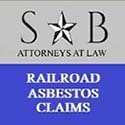
Railroad workers who were exposed to asbestos during their careers face an increased risk of developing life-threatening cancers, often decades after their exposure. Asbestos, once widely used in the railroad industry for its heat resistance and durability, has been definitively linked to a range of illnesses, including mesothelioma, lung cancer, throat cancer, esophageal cancer, stomach cancer, and colon cancer. These conditions not only take a physical toll but also place a significant financial burden on victims and their families.
If you or a loved one has developed an asbestos-related cancer due to occupational exposure, you may be entitled to substantial compensation. With over $30 billion currently held in asbestos trust funds, retired railroad workers and their families have options to seek justice and financial relief without enduring the stress of court proceedings. Sammons & Berry, P.C. specializes in guiding clients through the process, ensuring claims are filed accurately and efficiently to secure the compensation they deserve.
The Risks of Asbestos Exposure for Railroad Workers
For much of the 20th century, asbestos was a staple material in the construction, maintenance, and operation of trains. Railroad workers encountered asbestos in various ways, including:
- Locomotive Insulation: Asbestos was used extensively to insulate steam engines, pipes, and boilers. Workers repairing or replacing these components often released dangerous asbestos fibers into the air.
- Brake Pads and Clutches: Asbestos-containing brake pads and clutches were standard in railcars. Mechanics working on these parts risked inhaling asbestos dust during maintenance.
- Gaskets and Seals: Asbestos was used in gaskets and seals for its heat resistance, exposing workers during replacement or cutting of these materials.
- Maintenance Yards: Railroad maintenance facilities often had high levels of asbestos exposure, as workers conducted repairs and replaced parts in poorly ventilated spaces.
Over time, inhaled or ingested asbestos fibers can become lodged in the body, causing inflammation, scarring, and eventually cancer. Because asbestos-related cancers have long latency periods, workers may not experience symptoms until 20 to 50 years after their exposure.
Various Cancers Linked to Asbestos Exposure
Mesothelioma
Mesothelioma is a rare but aggressive cancer caused almost exclusively by asbestos exposure. It develops in the lining of the lungs (pleural mesothelioma), abdomen (peritoneal mesothelioma), or heart (pericardial mesothelioma). Symptoms include chest pain, shortness of breath, and fluid buildup in the lungs or abdomen. Because mesothelioma is often diagnosed in advanced stages, treatment options may be limited, including surgery, chemotherapy, and radiation therapy. While the prognosis remains poor, compensation can provide crucial financial support for treatment, palliative care, and family needs, offering some relief during an otherwise difficult time.
Lung Cancer
Asbestos exposure significantly increases the risk of lung cancer, particularly for individuals who smoked during their careers. Unlike mesothelioma, which originates in the mesothelium, lung cancer can develop in various parts of the lungs. Symptoms include persistent coughing, chest pain, difficulty breathing, and weight loss. Early detection can improve outcomes, but the disease often progresses without noticeable symptoms in its initial stages. Compensation for lung cancer related to asbestos exposure can help manage the costs of diagnostics, treatments, and lost income, while also providing long-term financial support for families.
Throat Cancer
Asbestos fibers can damage the lining of the throat over time, increasing the risk of laryngeal and pharyngeal cancers. These cancers may develop after prolonged exposure to airborne fibers, particularly in individuals who worked around asbestos-containing materials in enclosed environments. Symptoms often include hoarseness, persistent throat pain, difficulty swallowing, and a lump in the neck. Compensation can assist with medical costs and therapies needed to manage this cancer and its effects on speech and swallowing, as well as provide support for loved ones managing the illness.
Esophageal Cancer
Inhaled or ingested asbestos fibers can irritate and damage the lining of the esophagus, increasing the risk of esophageal cancer. This condition often develops silently, with symptoms such as difficulty swallowing, chest pain, persistent heartburn, and unintended weight loss appearing later. Given its strong association with occupational exposure, victims of esophageal cancer linked to asbestos may qualify for compensation to help offset medical costs and provide financial security during their recovery or for their families in the case of wrongful death claims.
Stomach Cancer
Stomach cancer has been linked to the ingestion of asbestos fibers, often through contaminated food or water in asbestos-heavy environments. Prolonged exposure can lead to cellular changes in the stomach lining, eventually resulting in cancer. Symptoms may include abdominal pain, bloating, nausea, loss of appetite, and unexplained weight loss. Diagnosis is often delayed, as early symptoms can resemble other gastrointestinal conditions. Compensation can support victims by covering advanced treatment costs, ongoing care, and other financial needs, ensuring that families are not burdened by medical expenses.
Colon Cancer
Asbestos exposure is also associated with an increased risk of colon cancer. Ingested asbestos fibers can cause inflammation and damage to the lining of the colon, potentially leading to cancer. Colon cancer symptoms include changes in bowel habits, rectal bleeding, abdominal discomfort, and fatigue. Compensation for victims of colon cancer related to asbestos exposure can help cover the extensive costs of treatment, including surgery, chemotherapy, and supportive care, and provide financial assistance to family members who may be affected by the disease’s long-term impact.
Filing a Claim for Compensation
For retired railroad workers diagnosed with asbestos-related cancers, pursuing compensation is often critical to managing medical expenses, covering lost income, and securing a financial future for loved ones. Fortunately, most claims can be filed without going to court.
1. Asbestos Trust Funds
Over $30 billion has been set aside in asbestos trust funds to compensate individuals affected by asbestos exposure. These funds are administered by companies that manufactured or used asbestos-containing products and later declared bankruptcy.
- Eligibility: To file a claim, you must provide evidence of your diagnosis and demonstrate that your illness resulted from asbestos exposure during your railroad career.
- Process: Claims are reviewed by trust administrators who determine eligibility and compensation amounts based on the severity of your condition and level of exposure.
2. Out-of-Court Settlements
In many cases, compensation is secured through settlements with companies responsible for asbestos exposure. Settlements avoid the need for a trial and often provide faster resolutions for victims.
3. Wrongful Death Claims
If a family member has passed away due to an asbestos-related cancer, surviving relatives may be eligible to file a wrongful death claim. These claims provide compensation for medical expenses, funeral costs, and the loss of financial and emotional support.
4. Upgrading Previous Claims
Many railroad workers who previously filed asbestos claims for non-cancerous conditions, such as asbestosis or pleural diseases, may be eligible to upgrade their claims if they are later diagnosed with cancer. The development of a more serious illness often qualifies victims for additional compensation.
How Sammons & Berry, P.C. Can Help
Sammons & Berry, P.C. specializes in assisting retired railroad workers with asbestos-related cancers in navigating the claims process. Their team has extensive experience in filing asbestos trust fund claims, negotiating settlements, and pursuing all available legal avenues to maximize compensation.
Key benefits of working with Sammons & Berry, P.C. include:
- Streamlined Claims Process: Their attorneys handle all aspects of the claim, including gathering evidence, filing paperwork, and communicating with trust administrators or company representatives.
- No Upfront Costs: The firm works on a contingency basis, meaning you only pay if they successfully recover compensation in your case.
- Expert Guidance: With a deep understanding of asbestos law and the railroad industry, they ensure claims are filed accurately and efficiently.
- Comprehensive Support: Whether you are filing an initial claim or upgrading a previous one, Sammons & Berry, P.C. provides personalized legal representation tailored to your unique circumstances.
The Importance of Acting Quickly
Time is of the essence when filing an asbestos-related cancer claim. Each state has a statute of limitations, limiting the time available to file a claim after a diagnosis or death. Missing this window could result in losing the opportunity to secure compensation, regardless of the severity of the illness or the strength of the evidence. Acting promptly is crucial to preserving your legal rights and ensuring your case is heard.
Moreover, asbestos trust funds have finite resources, and delays in filing could impact the amount of compensation available. Early action not only increases your chances of accessing these funds but also helps provide the financial support needed for medical treatments, caregiving, and other expenses. Sammons & Berry, P.C. can guide you through the process efficiently, ensuring no time is wasted.
Secondhand Asbestos Exposure and Its Devastating Effects
Secondhand asbestos exposure, also known as paraoccupational exposure, occurs when asbestos fibers are brought into homes or other environments on a worker’s clothing, hair, or personal items. Family members, particularly spouses and children of railroad workers, were often unknowingly exposed to these fibers when laundering contaminated clothing or interacting with the worker before they changed or showered.
This secondary exposure can be just as harmful as direct occupational exposure, leading to illnesses like mesothelioma, lung cancer, and other asbestos-related diseases decades later. Tragically, many family members of railroad workers have developed these illnesses without ever setting foot in an asbestos-heavy work environment. Victims of secondhand exposure may also be eligible for compensation through asbestos trust funds or other legal avenues. Sammons & Berry, P.C. is experienced in handling these cases and can help families understand their rights and options for seeking justice.
Secure the Compensation You Deserve
If you or a loved one has been diagnosed with mesothelioma, lung cancer, throat cancer, esophageal cancer, stomach cancer, or colon cancer due to asbestos exposure, you have options to secure financial relief. This includes claims for secondhand exposure, ensuring that family members affected by asbestos-related illnesses are not excluded from justice. Sammons & Berry, P.C. specializes in navigating the claims process, upgrading prior claims, and maximizing compensation for victims and their families.
Don’t let the complexity of legal proceedings deter you from seeking justice. Most claims are resolved without the need for court, offering a streamlined path to financial support for medical costs, caregiving, and other needs. Contact Sammons & Berry, P.C. today to schedule a free consultation and take the first step toward securing the compensation you deserve. Time is limited, so act quickly to protect your rights and secure the relief you and your family need.
See if you qualify for compensation
Sammons & Berry, P.C.
800-519-1440
View our Google Listing
View our Facebook


